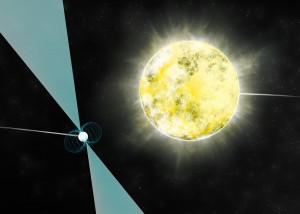
An artist's conception of a white dwarf star in orbit with pulsar PSR J2222-0137. Image Credit: B. Saxton, NRAO/AUI/NSF)
WASHINGTON (PTI): Astronomers have discovered an Earth-sized 'diamond' about 900 light-years away in space, which is possibly the coldest, faintest white dwarf star ever detected.
This ancient stellar remnant is so cool that its carbon has crystallised, forming - in effect - an Earth-size diamond in space. The object is likely the same age as the Milky Way, approximately 11 billion years old.
"It's a really remarkable object. These things should be out there, but because they are so dim they are very hard to find," said David Kaplan, a professor at the University of Wisconsin-Milwaukee.
Kaplan and his colleagues found this stellar gem using the National Radio Astronomy Observatory's (NRAO) Green Bank Telescope (GBT) and Very Long Baseline Array (VLBA), as well as other observatories.
White dwarfs are extremely dense end-states of stars like our Sun that have collapsed to form an object approximately the size of Earth. Composed mostly of carbon and oxygen, white dwarfs slowly cool and fade over billions of years.
Pulsars are rapidly spinning neutron stars, the superdense remains of massive stars that have exploded as supernovas.
As neutron stars spin, lighthouse-like beams of radio waves, streaming from the poles of its powerful magnetic field, sweep through space. When one of these beams sweeps across Earth, radio telescopes can capture the pulse of radio waves.
The pulsar companion to this white dwarf, dubbed PSR J2222-0137, was the first object in this system to be detected. It was found using the GBT by Jason Boyles, then a graduate student at West Virginia University in Morgantown.
These first observations showed that the pulsar was spinning more than 30 times each second and was gravitationally bound to a companion star, which was initially identified as either another neutron star or, more likely, an uncommonly cool white dwarf. The two were calculated to orbit each other once every 2.45 days.
The pulsar was then observed over a two-year period with the VLBA by Adam Deller, an astronomer at the Netherlands Institute for Radio Astronomy (ASTRON).
These observations pinpointed its location and distance from Earth - approximately 900 light-years away in the direction of the constellation Aquarius. This information was critical in refining the model used to time the arrival of the pulses at Earth with the GBT.
By applying Einstein's theory of relativity, researchers studied how the gravity of the companion warped space, causing delays in the radio signal as the pulsar passed behind it.
These delayed travel times helped the researchers determine the orientation of their orbit and the individual masses of the two stars. The pulsar has a mass 1.2 times that of the Sun and the companion a mass 1.05 times that of the Sun.
The research was published in the Astrophysical Journal.
 Previous Article
Previous Article Next Article
Next Article












The Indian Air Force, in its flight trials evaluation report submitted before the Defence Ministry l..
view articleAn insight into the Medium Multi-Role Combat Aircraft competition...
view articleSky enthusiasts can now spot the International Space Station (ISS) commanded by Indian-American astr..
view article